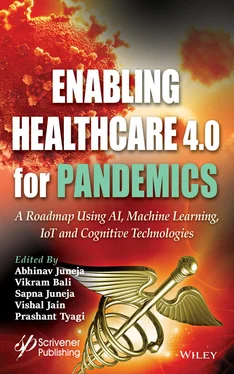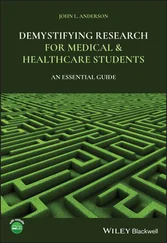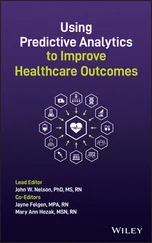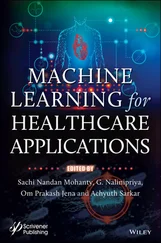© 2021 Scrivener Publishing LLC
For more information about Scrivener publications please visit www.scrivenerpublishing.com.
All rights reserved. No part of this publication may be reproduced, stored in a retrieval system, or transmitted, in any form or by any means, electronic, mechanical, photocopying, recording, or otherwise, except as permitted by law. Advice on how to obtain permission to reuse material from this title is available at http://www.wiley.com/go/permissions.
Wiley Global Headquarters111 River Street, Hoboken, NJ 07030, USA
For details of our global editorial offices, customer services, and more information about Wiley products visit us at www.wiley.com.
Limit of Liability/Disclaimer of Warranty
While the publisher and authors have used their best efforts in preparing this work, they make no representations or warranties with respect to the accuracy or completeness of the contents of this work and specifically disclaim all warranties, including without limitation any implied warranties of merchantability or fitness for a particular purpose. No warranty may be created or extended by sales representatives, written sales materials, or promotional statements for this work. The fact that an organization, website, or product is referred to in this work as a citation and/or potential source of further information does not mean that the publisher and authors endorse the information or services the organization, website, or product may provide or recommendations it may make. This work is sold with the understanding that the publisher is not engaged in rendering professional services. The advice and strategies contained herein may not be suitable for your situation. You should consult with a specialist where appropriate. Neither the publisher nor authors shall be liable for any loss of profit or any other commercial damages, including but not limited to special, incidental, consequential, or other damages. Further, readers should be aware that websites listed in this work may have changed or disappeared between when this work was written and when it is read.
Library of Congress Cataloging-in-Publication Data
ISBN 978-1-119-76879-1
Cover image: Russell Richardson
Cover design by Pixabay.Com
Set in size of 11pt and Minion Pro by Manila Typesetting Company, Makati, Philippines
Printed in the USA
10 9 8 7 6 5 4 3 2 1
The history of the universe has seen remarkable milestones in human evolution. We have evolved over the ages and witnessed a lot of disruption in this journey. However, human beings have matured and are now capable of harnessing the environment to make their lives easier. This ability of humans to adapt and make the best of natural resources has been a spectacular achievement. Today, we continue to explore existing technology and newer emerging technologies are also being rendered for making human lives more comfortable and reliable. However, there still are certain aspects of nature which remain unexplored by us. Several decades ago, epidemics were a common phenomenon which affected human civilizations economically as well as socially. Millions of lives were lost, but the spread of epidemics was limited to some particular geographical boundaries, and the demographics were confined. Currently, society has witnessed a newer phenomenon known as a “pandemic,” which is even a more critical situation compared to an epidemic as its geographical boundaries are not fixed and it spreads very quickly even before it can be sensed. COVID-19 is such a pandemic, as it originated in late 2019 in China and within a span of just three months affected every country across the globe.
The technological developments in the fields of artificial intelligence (AI) and machine learning (ML) are very exciting and encouraging. Using these techniques, we are able to make remarkable predictions and decisions. But our experiences during the current outbreak show that our technological arsenal was incapable of predicting the outbreak well in advance. Though there have been tremendous efforts by researchers to make such predictions and explore AI and allied technologies to tackle such problems and minimize their impact, this current pandemic has exposed many open issues. Apart from socioeconomic issues, such incidents have a longterm impact on civilizations. Due to COVID-19 the world came to a halt—there were no flights, trains, buses, cars and machines running anywhere. Industries and organizations across the globe were not prepared for such a big disruption in their daily operations and changes in the market supply and demand equilibrium. Though some countries have been able to control the outbreak in masses, by and large all the processes were trial and error approaches; and it has been observed that when restrictions on movements and recommended gathering size limitations are removed, the pandemic starts to spread its wings again.
In this book, we will explore the current state of practice using Healthcare 4.0 as a roadmap for harnessing AI, ML, the internet of things (IoT) and other modern cognitive technologies to help deal with various aspects of a pandemic outbreak. There is a need to improvise our healthcare system with the increasing intervention of modern computing and data management platforms to increase the reliability of human processes and life expectancy. There is also an urgent need to come up with smart IoT-based systems which can aid in detection, prevention and cure of these pandemics with precision. There are lots of challenges associated with all the open issues. The objective of this book is to provide a new approach for preparing for and organizing technological warfare against future pandemics with advances in Healthcare 4.0.
The significant contributions made by various authors have contributed to making this book a ready reference for developing an understanding of the technological resolutions sought in order to devise tools for addressing pandemic situations like those we are currently facing. The chapters of this book are related to processes and technologies that may be helpful for dealing with pandemics of the modern era and other such related unforeseen natural disasters. A brief chapter-by-chapter description of the book follows:
Chapter 1, “COVID-19 and Machine Learning Approaches to Deal with the Pandemic,” gives an overview of the efforts and strategies used by organizations across the globe during the COVID-19 pandemic using AI and ML techniques in various fields ranging from manufacturing, resource management, remote monitoring, etc. In addition, an ML approach being used by researchers for supporting healthcare-related issues raised by COVID-19 is discussed.
Chapter 2, “Healthcare System 4.0 Perspectives on the COVID-19 Pandemic,” explores the leading HCS 4.0 techniques that could address this pandemic, highlighting real-world applications, opportunities, challenges and future insights.
Chapter 3, “Analysis and Prediction of COVID-19 Using Machine Learning,” makes use of various Python libraries, namely, scikit-learn, matplotlib for data visualization, NumPy and pandas for data manipulation.
Chapter 4, “Rapid Forecasting of a Pandemic Outbreak Using Machine Learning,” proposes a strategy for the preliminary estimation of how COVID-19 spreads across the globe, its possible treatments, and the prevention of outbreaks by making use of technologies like ML, which may prove beneficial in saving the human race from pandemics like COVID-19 in the future.
Chapter 5, “Rapid Forecasting of Pandemic Outbreak Using Machine Learning: The Case of COVID-19,” assesses different models and proposes an early warning system that uses AI to make conjectures on the likelihood of potential flare-ups of ailments.
Читать дальше












